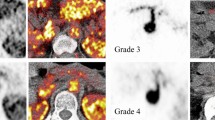Abstract
Objective
Positron emission tomography (PET) angiography utilizes early dynamic PET acquisitions for depiction of the arterial vasculature. The aim of this study was to assess image quality and to evaluate feasibility of F-18 FDG PET angiography of the abdominal arteries.
Methods
Twenty-seven patients were included in the study. Standard activities of 250–280 MBq F-18 FDG were administered. Early dynamic PET data were acquired in list mode. Time frames of 6 × 10 s after tracer injection were reconstructed. Images were analyzed in MPR and MIP modes. Image quality was scored according to scale from 1 to 4. PET angiography findings were compared with contrast-enhanced CT imaging.
Results
All examinations were completed successfully. In 83 % of cases, best arterial contrast was seen between 10 and 40 s after tracer injection. Good or moderate diagnostic image quality of the aorta was noted in all the cases, with a 100 % negative predictive value of a normal finding. Celiac trunks, renal and superior mesenteric arteries could be visualized with limited image quality, good to excellent negative predictive values of 90–100 %, and low positive predictive values of 3–13 % due to overestimation of arterial occlusive disease and false-positive findings.
Conclusions
F-18 FDG PET angiography is technically feasible and can exclude relevant abdominal aortic occlusive disease. Clinical use in the evaluation of smaller arteries of the upper abdomen is limited. The main advantages of PET angiography are the absence of acute risks to the patient and the possibility to acquire the data as part of routine PET/CT studies.





Similar content being viewed by others
References
Treglia G, Mattoli MV, Leccisotti L, Ferraccioli G, Giordano A. Usefulness of whole-body fluorine-18-fluorodeoxyglucose positron emission tomography in patients with large-vessel vasculitis: a systematic review. Clin Rheumatol. 2011;30:1265–75.
Rusten E, Rodal J, Revheim ME, Skretting A, Bruland OS, Malinen E. Quantitative dynamic 18FDG-PET and tracer kinetic analysis of soft tissue sarcomas. Acta Oncol. 2013;52:1160–7.
Bernstine H, Braun M, Yefremov N, Lamash Y, Carmi R, Stern D, et al. FDG PET/CT early dynamic blood flow and late standardized uptake value determination in hepatocellular carcinoma. Radiology. 2011;260:503–10.
Shiomi S, Kawabe J. Clinical applications of positron emission tomography in hepatic tumors. Hepatol Res. 2011;41:611–7.
Di Carli MF, Murthy VL. Cardiac PET/CT for the evaluation of known or suspected coronary artery disease. Radiographics. 2011;31:1239–54.
Stecker FF, Schierz JH, Opfermann T, Driesch D, Hofmann GO, Winkens T, et al. Early dynamic 18F-FDG PET/CT to diagnose chronic osteomyelitis following lower extremity fractures. A pilot study. Nuklearmedizin. 2014;53:117–22.
Mullani NA, Herbst RS, O’Neil RG, Gould KL, Barron BJ, Abbruzzese JL. Tumor blood flow measured by PET dynamic imaging of first-pass 18F-FDG uptake: a comparison with 15O-labeled water-measured blood flow. J Nucl Med. 2008;49:517–23.
Kristian A, Revheim ME, Qu H, Maelandsmo GM, Engebraten O, Seierstad T, et al. Dynamic (18)F-FDG-PET for monitoring treatment effect following anti-angiogenic therapy in triple-negative breast cancer xenografts. Acta Oncol. 2013;52:1566–72.
Drescher R, Freesmeyer M. PET angiography: application of early dynamic PET/CT to the evaluation of arteries. AJR Am J Roentgenol. 2013;201:908–11.
Kramer U, Nael K, Laub G, Nyborg GK, Fenchel M, Miller S, et al. High-resolution magnetic resonance angiography of the renal arteries using parallel imaging acquisition techniques at 3.0 T: initial experience. Invest Radiol. 2006;41:125–32.
Pfeil A, Betge S, Poehlmann G, Boettcher J, Drescher R, Malich A, et al. Magnetic resonance VIBE venography using the blood pool contrast agent gadofosveset trisodium—an interrater reliability study. Eur J Radiol. 2012;81:547–52.
Namasivayam S, Kalra MK, Torres WE, Small WC. Adverse reactions to intravenous iodinated contrast media: a primer for radiologists. Emerg Radiol. 2006;12:210–5.
Rhee CM, Bhan I, Alexander EK, Brunelli SM. Association between iodinated contrast media exposure and incident hyperthyroidism and hypothyroidism. Arch Intern Med. 2012;172:153–9.
Coresh J, Selvin E, Stevens LA, Manzi J, Kusek JW, Eggers P, et al. Prevalence of chronic kidney disease in the United States. JAMA. 2007;298:2038–47.
Wiginton CD, Kelly B, Oto A, Jesse M, Aristimuno P, Ernst R, et al. Gadolinium-based contrast exposure, nephrogenic systemic fibrosis, and gadolinium detection in tissue. AJR Am J Roentgenol. 2008;190:1060–8.
Hanna RF, Kased N, Kwan SW, Gamst AC, Santosa AC, Hassanein T, et al. Double-contrast MRI for accurate staging of hepatocellular carcinoma in patients with cirrhosis. AJR Am J Roentgenol. 2008;190:47–57.
Piscaglia F, Nolsoe C, Dietrich CF, Cosgrove DO, Gilja OH, Bachmann Nielsen M, et al. The EFSUMB Guidelines and Recommendations on the Clinical Practice of Contrast Enhanced Ultrasound (CEUS): update 2011 on non-hepatic applications. Ultraschall Med. 2012;33:33–59.
Shiga T, Morimoto Y, Kubo N, Katoh N, Katoh C, Takeuchi W, et al. A new PET scanner with semiconductor detectors enables better identification of intratumoral inhomogeneity. J Nucl Med. 2009;50:148–55.
Acknowledgments
This study was funded from the Jena University Hospital budget.
Conflict of interest
The authors declare that there are no conflicts of interest.
Author information
Authors and Affiliations
Corresponding author
Rights and permissions
About this article
Cite this article
Drescher, R., Freesmeyer, M. F-18 fluorodeoxyglucose PET angiography of the abdominal arteries: evaluation of image quality and comparison with contrast-enhanced CT. Ann Nucl Med 29, 198–205 (2015). https://doi.org/10.1007/s12149-014-0930-x
Received:
Accepted:
Published:
Issue Date:
DOI: https://doi.org/10.1007/s12149-014-0930-x




